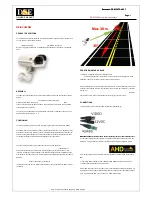
Triggered acquisition - single frame
Sensors support exposure overlapped with readout. When the trigger period (t
tper
) is longer than the exposure plus readout time, exposure
is not overlapped with readout. However, when the trigger period is decreased, the sensor will expose the images in overlap mode. In this
case, the frame active signal will be constantly active. The trigger period has to be long enough, so the exposure of next frame does not
end sooner than readout of previous frame.
Sensor timing in Exposure Overlapped with Data Readout Mode
Figure 54: acquisition mode - triggered with overlap
Description
t
eio
Trigger (Digital Input) to Exposure Active (Digital Output)
t
exp
Trigger (Digital Input) to start of exposure
t
exps
Current Exposure Time set (XI_PRM_EXPOSURE)
t
fot
Frame overhead time (FOT)
t
rd
readout time (Readout Time)
t
row
readout time of one row (Line period) depends on sensor settings
Conditions: Debounce on trigger input line and trigger delay are disabled.
The timing strongly depends on camera settings. Most of the times can be calculated using
The delay between trigger input and start of exposure:
t
exp
= 3
×
t
row
+
t
idelay
t
idelay
– Delay inside camera caused by internal electronics. This depends on input type. Please refer to:
Optically isolated digital input
The output signaling is then delayed the delay introduced from the output electronic:
t
eio
=
t
row
+
t
odelay
t
odelay
– Delay inside camera caused by internal electronics. This depends on output type. Please refer to:
Optically isolated digital output
For minimum trigger period (
t
tper
) the following applies. The next trigger after one is processed needs to be applied so the end of the
triggered exposure does not overlap with the readout of the previous frame.
t
per
> max
(
t
rd
, t
exp
+
t
f ot
)
XIMEA Technical Manual, Version: v230927
56
















































